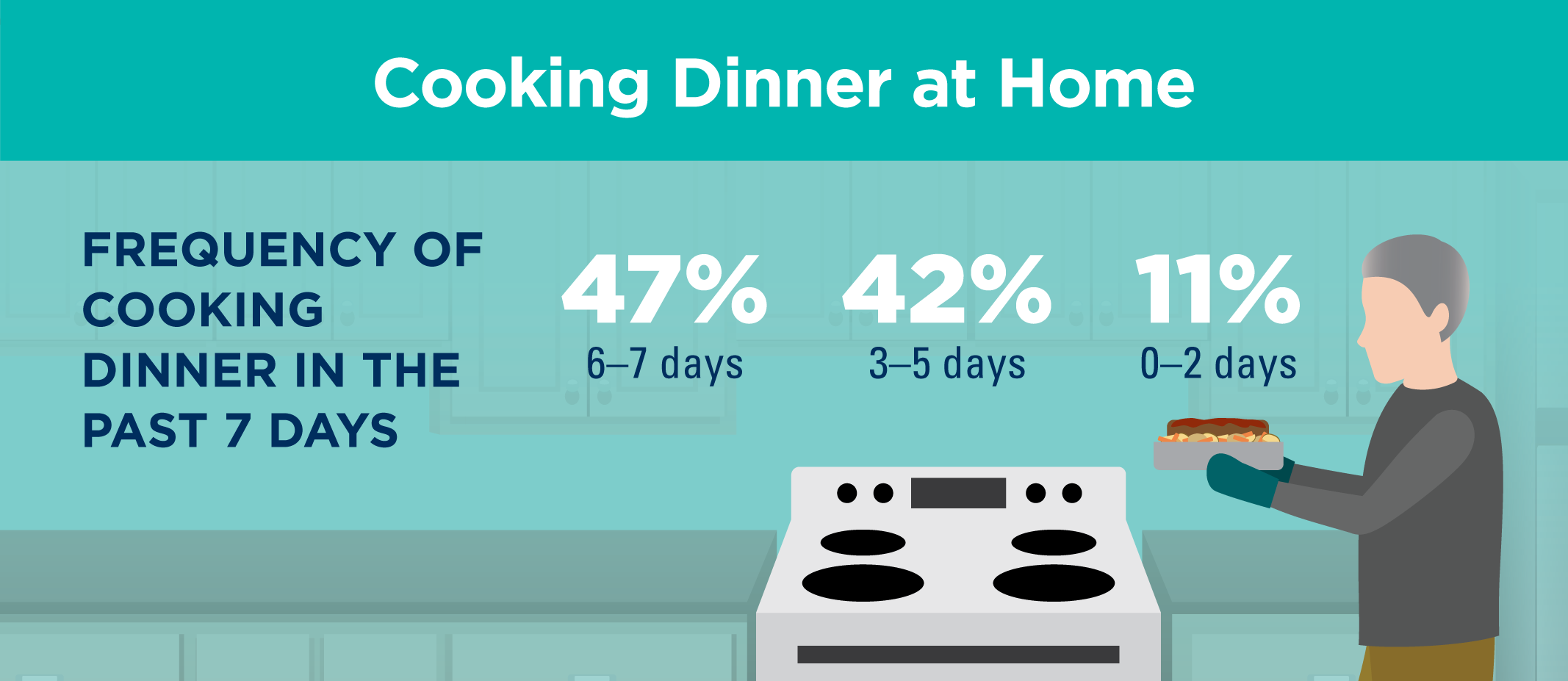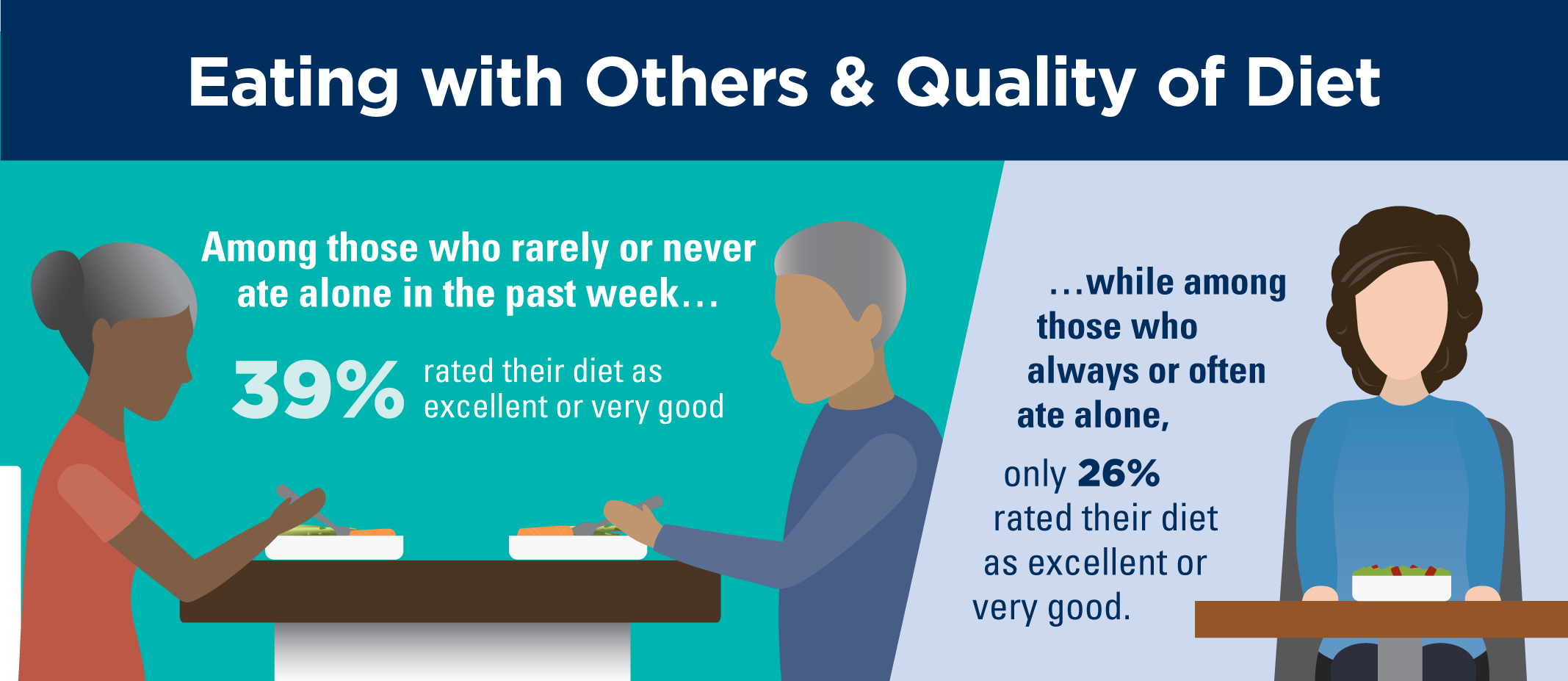
Cooking nutritious meals at home can be a key strategy for healthy eating, particularly in an environment dominated by fast food, carry out, and processed foods. Cooking at home has become especially important during the COVID-19 pandemic, which has forced many people to stay at home and most restaurants to close or limit service. Cooking at home can also have cognitive, social, and emotional benefits. However, changes associated with aging may present challenges to cooking and healthful eating.
In December 2019, before the COVID-19 pandemic, the University of Michigan National Poll on Healthy Aging asked a national sample of adults age 50–80 about cooking and grocery shopping to better understand factors that affect the food habits of older adults in the U.S. Though these data were collected prior to widespread stay-at-home orders, they are useful to examine norms and trends that may influence how older adults shop and cook both during and after the pandemic.
Eating at home and outside the home
About half of adults age 50–80 (47%) said they (or someone in their household) cooked food for dinner at home frequently (6–7 days) in the past week. Two in five (42%) reported having cooked food for dinner 3–5 days in the past week, while 11% said they cooked dinner 0–2 days in the previous week. Adults age 65–80 and White and other/multi-race respondents reported cooking food for dinner at home more often than adults age 50–64 and Black respondents.

While many older adults often cook dinner at home, they also frequently reported eating out. About half reported eating at fast food restaurants at least once in the past week (51%), including 11% who said they ate fast food three or more times. Slightly more than half of respondents (53%) ate at dine-in or sit-down restaurants at least once a week, and 11% did so three or more times in the past week. One in three older adults (34%) reported eating take out or delivery food at least once in the past week, but only 4% did so three times per week or more.
While more than half of respondents (54%) said they rarely or never ate alone in the past week, nearly one in four (24%) said they always or often ate alone in the past week.
Attitudes about cooking
The majority of adults age 50–80 said they enjoyed cooking (71%), and most were confident cooking with basic ingredients (86%). Enjoyment of cooking was more common among those who self-reported being in excellent or very good physical health compared to those reporting fair or poor physical health.
Few older adults felt that cooking takes too much time (28%), is difficult (14%), or costs too much money (9%). Difficulty cooking meals was more common among individuals with fair or poor physical or mental health compared to those with excellent or very good physical or mental health.
Connection between cooking at home and a healthy diet
When asked to rate the overall health of their diet, a third of respondents (34%) rated their diet as excellent or very good, 43% rated it as good, and 23% said it was fair or poor. Older adults who cooked dinner at home 6–7 days per week were more likely to describe their diet as excellent or very good (42%) compared to those who cooked dinner at home two or fewer days per week (23%). Respondents who regularly eat fast food were more likely to rate their diet as less healthy. Eating with others was also associated with a healthier diet. Of those who always or often ate alone, only 26% described their diet as excellent or very good, compared to 39% of those who rarely or never ate alone.

Food shopping habits
Most respondents said they (or someone else on their behalf) go shopping for food once a week (45%) or more than once a week (23%), and most do so by going to the store; only 5% reported getting groceries through a curbside pickup or home grocery delivery service. Few respondents reported barriers to grocery shopping. Overall, 10% reported that lack of time makes it difficult to grocery shop. Other barriers to shopping reported by fewer than one in ten respondents included: physical limitations, lack of transportation, no grocery store nearby, caregiving responsibilities, and hours stores are open.
Implications
The results of this poll, collected before the COVID-19 pandemic, suggest that the majority of older U.S. adults cook dinner at home frequently. Those who cooked dinner more often rated their diet as healthier compared to those who cooked dinner less frequently.
Prior to widespread social distancing guidelines and stay-at-home orders due to the pandemic, older adults reported going food shopping frequently and only rarely using curbside pickup or home grocery delivery services. Consequently, these services may be unfamiliar or not viewed as a possibility for many older adults, and it will be important to track how usage has changed due to the pandemic.
Social distancing measures have initiated widespread changes to cooking and food shopping practices across the population. In addition, high unemployment has increased food insecurity, creating financial barriers to accessing sufficient and nutritious food for many households. For many older adults, accessing grocery stores has also become more difficult due to fear of exposure to COVID-19 and changes in store hours and operations. As the pandemic evolves, it will be important to understand how shopping and cooking practices have changed as well as the effect of those changes on diet, overall health, and well-being.
In addition to cooking dinner frequently at home, results also show that, prior to the pandemic, older adults ate out frequently, including at fast food restaurants. Strong evidence links consumption of fast food and other highly processed foods with lower diet quality and higher rates of health conditions such as obesity, diabetes, hypertension, and some cancers.
Many respondents were confident in their ability to cook and had positive attitudes about cooking at home. Cooking meals for oneself or others can provide numerous health and social benefits. Following recipes and cooking meals can also help people stay physically and mentally active as they age.
In recent years, cooking at home has emerged as a key strategy for healthy eating that many older adults already engage in frequently and report as a source of enjoyment. Strategies to help older adults who are less confident cooking is even more important now that eating at home is necessary for many. The special circumstances of the COVID-19 pandemic have highlighted both the barriers that many Americans face when it comes to accessing high-quality, nutritious ingredients for cooking healthy meals, while also underscoring the importance of food access and the ability to cook at home.
Strategies or special services to help older adults continue to safely shop for food and prepare healthy meals at home during the COVID-19 pandemic are needed. For example, for those who find getting to the store difficult or are currently reluctant to shop for groceries themselves, strategies to facilitate use of grocery delivery or curbside pickup services may help ensure continued access to healthy foods. In addition, when people feel comfortable eating meals outside the home again, increased use of strategies such as menu labeling and accessible and transparent nutrition information will be important for helping people make healthy choices when eating at restaurants or carrying out.
Eating a healthy diet has always been important for maintaining good health. Helping older adults learn to cook healthfully at home and when eating or carrying out could have numerous benefits for maintaining health as individuals age.
Data Source and Methods
This National Poll on Healthy Aging report presents findings from a nationally representative household survey conducted exclusively by Ipsos Public Affairs, LLC (“Ipsos”), for the University of Michigan’s Institute for Healthcare Policy and Innovation. National Poll on Healthy Aging surveys are conducted using the Ipsos KnowledgePanel®, the largest national, probability-based panel in the U.S. Surveys are fielded two to three times a year with a sample of approximately 2,000 KnowledgePanel® members age 50–80.
This survey module was administered online in December 2019 to a randomly selected, stratified group of older adults age 50–80 (n=2,048). Respondents were selected from the Ipsos web-enabled KnowledgePanel®, which closely resembles the U.S. population. The sample was subsequently weighted to reflect population figures from the U.S. Census Bureau.
The completion rate was 77% among panel members contacted to participate. The margin of error is ±1 to 3 percentage points for questions asked of the full sample and higher among subgroups.
Findings from the National Poll on Healthy Aging do not represent the opinions of the University of Michigan. The University of Michigan reserves all rights over this material.
Read other National Poll on Healthy Aging reports and about the poll's Michigan findings, and learn about the poll methodology.
Citation
Wolfson, J, Kullgren J, Singer D, Kirch M, Malani P, Solway E, Leung C. The Joy of Cooking and its Benefits for Older Adults. University of Michigan National Poll on Healthy Aging. June 2020. Available at: http://hdl.handle.net/2027.42/155433